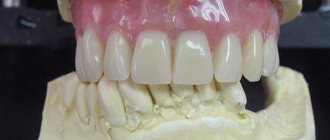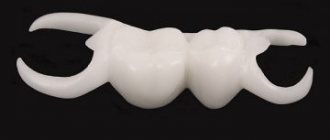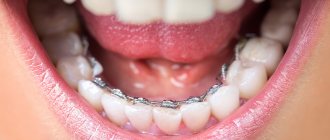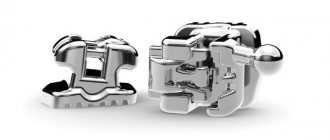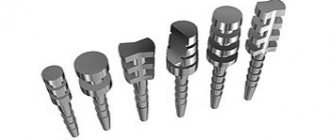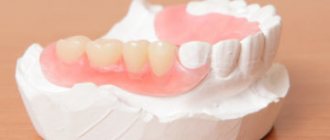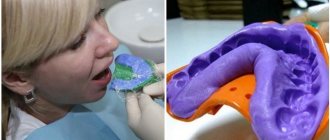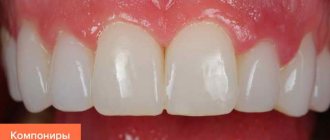What are composite veneers and their composition
Composite (direct) veneers are special overlays on the front surface of the teeth, which are made from composite materials in the patient’s mouth. The reflective material is applied in layers directly to the surface of the teeth. One visit to the dentist is enough to complete the procedure.
A composite is a spatial three-dimensional combination of two or more chemical substances, in which there is a clear interface - it can be seen even with the naked eye. This combination enhances the properties of each component several times.
The first composite materials entered the dental market in 1964, but since then they have evolved, becoming more convenient and safer for humans, because during this period:
- new adhesives were created;
- the color scheme was improved;
- the strength of materials increased.
The main components of a modern composite:
- polymer matrix consisting of:
- polymerization inhibitor, which increases the shelf life of the substance;
- main and additional catalyst;
- activator;
- an ultraviolet absorber that prevents the color of the linings from changing when exposed to sunlight;
- inorganic filler, thanks to which:
- the aesthetic properties of microprostheses are increased, since the mineral filler has physical characteristics close to natural teeth;
- material deformation is prevented;
- the hardness and resistance of the composite increases;
- Surfactants or silanes are organosilicon compounds that increase the strength of the material.
Of these three components, the properties and differentiation of the composite are most influenced by fillers, which are classified based on the following characteristics:
- according to the material:
- from quartz;
- from silicon dioxide;
- from diamond dust;
- made of barium glass;
- According to the size of filler particles, there are composites from 0.04 to 45 microns;
- by particle shape:
- sticks;
- antennae;
- spirals;
- shavings;
- dust;
- ground.
Most dental composites used to make veneers are primarily composed of ground barium glass particles, but much depends on the manufacturer.
What are the advantages of composite veneers?
The main advantage of this type of tooth restoration is its low cost. The use of inexpensive composite material allows for restoration without the use of complex technologies.
The second significant advantage is the shortest possible time for carrying out the procedure. The installation process is completed in one visit to the dentist. In order to restore a tooth with such an onlay, a specialist does not need to take plaster casts and send them to a special laboratory. The material is applied layer by layer to the desired surface of the incisor, immediately in the dental chair.
But it's not that simple. Simple manufacturing technology entails significant disadvantages, which also need to be taken into account when choosing. The main one is that the pad has a low degree of adhesion to the surface of the cutter. This causes bacteria to multiply and plaque to accumulate, especially at the border between the veneer and the tooth. As a result, inflammation of the gums is provoked and caries forms.
If we compare composite veneers with ceramic ones, the aesthetic appearance of the former leaves much to be desired. The linings darken and become stained as their service life increases. When using them, the patient will have to strictly monitor food products, taking into account the presence of natural or natural dye in them.
I would also like to note the reliability of the composite material used. Its high fragility leads to the fact that the linings are ground down, acquiring a rough surface. And eating solid foods in the form of nuts or seeds can lead to the formation of cracks on the surface.
Classification of composite onlays for teeth
Composite veneers are classified based on the number and size of particles they contain. According to this criterion, composite linings are divided into:
- cheap veneers with large composite particles (more than 30 microns): they quickly fade and cannot be further processed;
- overlays with mini-filler and particles up to 1.5 microns;
- hybrid composite veneers with particles measuring about 1 micron;
- microprostheses with microparticles (up to 0.04 microns), used exclusively to restore the aesthetic appearance of the front teeth.
Flaws
Composite veneers made using the direct method have a number of disadvantages that must be taken into account before installing them on teeth:
- After some time, the linings can change their color. This is due to the ability of composites to absorb dyes. To extend the life of therapeutic veneers, you should limit your consumption of highly pigmented foods.
- Shorter wear period than ceramic plates. This happens because unfilled spaces remain between the enamel and the composite, which disrupts the adhesion of the material to hard tissues.
- The product is fragile, so if excessive mechanical loads are placed on the front teeth, the veneers may break off.
- Microcracks and chips may form along the border between the hard tissues of the tooth and the restoration. This not only spoils the appearance of the veneer, but also increases the likelihood of developing caries.
Despite all the negative aspects of therapeutic veneers, their popularity among patients does not decrease.
Indications for installation
Veneers made of composite material perfectly mask the following dental defects:
- abnormal shape of teeth;
- dental chips;
- wide spaces between teeth;
- uneven contours of the front teeth;
- displacement of crowns in the vertical plane;
- yellow or gray spots on the enamel that cannot be bleached;
- age-related change in enamel shade;
- thinning teeth;
- defect of the filling material: change in color of the filling, slight chipping;
- increased wear of crowns.
The installation of veneers is indicated if it is necessary to visually correct the condition of several teeth in the smile area. But in case of significant defects, it is more advisable to use other dental methods for correcting the dentition.
In what cases is it relevant to use?
With the help of composite veneers, you can visually hide only minor defects. These include:
- With age, teeth change color;
- the shape of the incisor has changed (consequences of abrasion or injury);
- enamel pigmentation has occurred that cannot be whitened (pigmented cracks, fluorosis or tetracycline teeth);
- the existence of diastemas or trema;
- slight mixing of teeth in the vertical axis;
- if there is a defect in the filling, but it is stable (for example, the filling material has darkened over time);
- a composite plate can hide defects in an underdeveloped tooth that formed during its development (for example, amelogenesis or hypoplasia);
- in cases of uneven contour of the incisor neck;
Sometimes, with the help of direct composite veneers, it is possible to change the group affiliation of a tooth. An example would be the visual change from a canine to a lateral incisor.
Contraindications for installation
Direct veneering is contraindicated in the following cases:
- insufficient oral hygiene, as there is a high risk of developing caries directly under the linings;
- the presence of carious cavities;
- malocclusion and the need to wear braces;
- the presence of inflammatory processes in the mouth;
- bruxism;
- tooth mobility;
- erupting wisdom tooth;
- the presence of pulpless dental units, as they are more prone to destruction;
- serious enamel defects.
If the listed pathologies are eliminated, anyone can get direct composite veneers, and they will last for quite a long time.
Contraindications
The dentist dissuades the patient from installation in the following cases:
- A person with a pathological form of bite: reverse or direct.
- The patient is involved in dangerous sports where strong blows to the head are possible: boxing, football, hockey. Under such circumstances, it is a waste of money - the veneers will crumble.
- The client has an increased degree of enamel abrasion.
- They are too close to each other, touching. When grinding, dental structures are destroyed.
- Crooked, weakened, too short, mutilated.
- Cavities or gum disease develops.
The client decides what suits him. But it is better to listen to the recommendations of a certified doctor.
Advantages and disadvantages of veneering
The main advantages of composite veneers include:
- speed of production and installation: you don’t even need to make additional impressions;
- durability subject to proper use and quality care;
- beautiful appearance;
- maximum naturalness: modern composite materials transmit light well.
But composite veneers also have disadvantages:
- relative fragility, which manifests itself if a person does not take care of the pads and does not use suitable personal hygiene products;
- slight masking ability, which manifests itself in the presence of teeth that are too dark in color or bright, prominent spots (due to tetracycline);
- the need to grind down the enamel: after removing the veneers, the teeth need to be restored.
If only the central and lateral incisors are restored using veneering, then the remaining teeth often have to be whitened.
The quality of installation of veneer microprostheses depends on the skill of the dentist. Not all dentists can beautifully install veneers, so before installing them, it is recommended to check with the doctor about his track record and ask for photos of the work he has performed.
You should also pay attention to the cost of veneers, since professionals do not work at minimum prices. The approximate average cost of one direct composite veneer in Moscow and St. Petersburg is 8–9 thousand rubles. for one tooth . Minimum prices for composite veneers start from 4 thousand 500 rubles. Veneering is not covered by compulsory medical insurance, as it is a cosmetic procedure.
average cost
The cost of installing composite veneers in different cities of Russia may vary. The price of a service within the same locality, but provided by different dental clinics, will also vary. The difference in cost is determined by many reasons:
- clinic level;
- volume of preliminary work;
- use of anesthesia or refusal of it;
- choosing the installation method;
- materials used, etc.
The minimum price for the entire procedure in Moscow is about 3,000 rubles, while the maximum cost can be 5 times higher.
To correctly calculate the necessary funds, you should familiarize yourself with the price list for services in advance. Such information is always available on the websites of clinics and dental centers.
Stages of manufacturing direct composite veneers
It is better to do dental overlays in the first half of the day, when it is light and sunny. This will help the dentist correctly select the shade of the material. Direct veneers are made in the patient's mouth. The whole procedure consists of several stages:
- Visual inspection and sanitation of the oral cavity. A few days before the procedure, you can undergo a professional teeth cleaning session.
- Choosing the shade of veneers according to the Vita scale. The most responsible approach to choosing the color of the composite material is if you need to place literally 1-2 veneers and you want these veneers to be no different from the rest of the dentition.
- Hardware grinding of the teeth to which the composite material will be applied.
- Applying layers of composite material to the front surface of the teeth. Typically, 7 layers of material are required to achieve maximum strength of a microprosthesis.
- Turning and grinding of veneers.
Care
In order for veneers to last a long time, it is necessary to adhere to the rules of caring for the structure: carry out high-quality and regular teeth cleaning and do not create excessive pressure on the teeth with onlays. Although veneers are a durable structure, if too much pressure is applied they can chip off the surface of the tooth.
Review (Galina, 23 years old): “I got composite veneers 6 months ago because I had yellow enamel and a slightly uneven bite. With the help of veneers, your teeth become straighter and brighter, but they don’t look like a Hollywood smile. Maybe someone had ready-made veneers attached; they look better, but for me the doctor did each tooth for 1.5 hours. I try not to use coloring products, but my teeth still change their color a little, the doctor said that this is the material. Every two months I go to polish my teeth to prevent them from getting dark around the edges. Overall, I’m happy that I got composite veneers, but in a few years I plan to change to ceramic ones.”
To prevent this complication, it is recommended not to overload your teeth with hard and tough foods; to do this, you need to carefully use crackers, dried fruit, nuts, etc. The presence of veneers does not require additional special dental care. It is enough to carry out regular high-quality brushing of your teeth twice a day with a toothbrush and paste, use dental floss to clean the interdental spaces, rinse your mouth and periodically visit a doctor.
If darkening occurs at the junction of the veneer into the tooth, the lining becomes detached, or the sensitivity of the teeth increases, you must immediately contact a specialist. For timely diagnosis, treatment and prevention, you need to go to the dentist twice a year. Every six months it is recommended to remove dental plaque.
Product service life
Manufacturers of veneers claim that microprostheses can last in the mouth for about 5–6 years, but in fact it is better to focus on a period of 3–4 years. Moreover, the veneer will lose its whiteness and shine approximately a year after installation, which is due to the large amount of dyes consumed in food and a violation of the acid-base balance in the oral cavity.
Changing the color of veneers is facilitated by:
- red wine;
- spices like curry;
- coffee;
- strong tea;
- colored carbonated drinks.
After veneering, it is recommended to avoid coloring products or reduce their consumption to a minimum. If a person smokes, then it is better for him to install ceramic veneers rather than composite ones. Composites are easily stained from exposure to cigarette smoke.
Differences between ceramics and composite
In this section, you will learn the difference between composite and ceramic veneers, what materials they are made from, and how long it takes to install onlays on teeth.
- Composite veneers are made from a filling material that is applied directly, layer by layer, into the mouth. This is a creative and painstaking process that requires high skill of the dentist, since the onlays must look natural and fit organically in the oral cavity.
- Porcelain veneers are made from porcelain. Such plates are made from an impression of the patient’s teeth in the laboratory. Veneers are fixed to the teeth using a composite. Several methods are used to make onlays: layering ceramic powders, injection molding, and milling from solid blocks.
In addition, there are two subtypes of veneers: compositers and lumineers.
- Componeers are overlays made of nanohybrid composite. Like composite veneers, they are fixed to the teeth directly, without fabrication in the laboratory, and are installed in one visit. Composites look like ceramic veneers, but are several times cheaper.
- Lumineers are plates made of high-strength porcelain. They are two times thinner than veneers (0.1 mm instead of 0.2 mm), so they are installed on the teeth without preliminary grinding. Thanks to this, lumineers can be removed at any time without harm to dental health.
Note. There is a myth that there are zirconium veneers. In fact, only crowns can be made from zirconium dioxide. The fact is that veneers are always attached adhesively. This fixation method involves etching the ceramics. Thanks to it, the surface of the material becomes rough, and the veneers stick to the teeth. Zirconium dioxide cannot be etched - the surface of the material remains smooth. This means that zirconium veneers cannot be fixed to the teeth.
Which veneers are better - ceramic or composite? There is no clear answer to this question. It all depends on the selection criteria: appearance, installation time, possibility of restoration, service life or price.
Despite the difference in material and manufacturing technology, all types of veneers protect teeth from caries, hide enamel defects and are quite easy to care for. However, ceramic veneers have several advantages: they do not change shape and color over time, they look natural and natural.
Componeer direct composite veneers
Componers are used to improve the color of the surface of teeth and to restore their shape. They are ready-made enamel overlays. Installation of compositors is faster and easier due to the fact that the period of preparation of the oral cavity for restoration is reduced.
Componers cannot be installed if:
- occlusion;
- periodontal pathologies;
- parafunction of masticatory muscles;
- significant tooth decay.
There is no grinding when installing composites, which preserves the appearance and health of the treated teeth. If microprostheses need to be removed in the future, no additional enamel restoration will be required.
Advantages
Composites have advantages over other types of overlays:
- No grinding required.
- The procedure (diagnosis, manufacturing, installation) will not take more than one visit to the dental office.
- Remove dental damage.
- If necessary, the cover can be easily removed and put back on.
- When replacing one or two teeth, you don't have to worry about them standing out from the rest. The doctor will select the right shade and shape.
- Composite ones are durable;
- Low price compared to competitive forms of veneering.
Possible disadvantages
- Veneer structures change shade to dark.
- If the patient intends to wear the plates for a long time, he refuses to eat certain foods. Substances that wear away enamel or stain the surface of the dental cortex are excluded.
- Although the pads are durable, if not cared for or used incorrectly, they will crack, scratch, or break.
- There are differences in the structure of the jaw. Sometimes veneers may not be suitable or cause a lot of hassle, inconvenience, and pain.
Photos before and after installing veneers using the direct method
Teeth before and after installation of veneers
Teeth affected by fluorosis before and after veneering
Installing direct composite veneers is a relatively inexpensive way to make your smile beautiful and snow-white. This procedure is carried out for many pathologies, but the durability and naturalness of microprostheses depend on the professionalism of the dentist and the equipment of the dental clinic.
Hollywood veneers
If all the teeth are healthy and a person is not satisfied only with the color or shape, then the best way out is not to do anything with them other than disinfection, but to try to correct the appearance using only thin overlays, which in this case are called Hollywood veneers.
For example, if two large central teeth stand out in size from the others, then instead of grinding them down and reducing them, it is enough to simply enlarge a pair of adjacent teeth on the left and right with overlays. The photo before the procedure and after the correction clearly shows that amazing changes are sometimes achieved by very modest means: a change in color and minor adjustments in shape. To avoid a horse-like smile, Hollywood veneers are made as thin as possible , up to 0.3 mm, and to distinguish them from the group of ordinary ones, brand names such as lumineers, vivaneers, ultraneers, etc. are invented.
Veneers for teeth
Dental defects that can be easily corrected with Hollywood veneers:
- irregular teeth shape;
- unsatisfactory color;
- visible filling, traces of restoration;
- enamel abrasion;
- chips and cracks;
- spaces between teeth (front or side).
Lumineers are thin ceramic onlays made individually, based on exact impressions of teeth. They have great strength, hardness, excellent appearance, and are transparent like tooth enamel. The durability and aesthetic qualities of ceramic lumineers justify their fairly high cost. On the American website www.lumineers.com, the price of lumineers per tooth is indicated from 800 to 2000.
The cost of such branded ceramics Cerinate (USA) in Russia is indicated: from 35,000 to 50,000 rubles. The discounts are explained by well-established connections with the manufacturer. Such a high cost is associated not only with the lack of high-tech production in Russia, but also with very good application statistics, and such a thing looks beautiful and very expensive.
